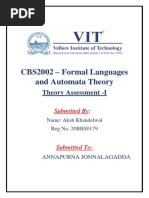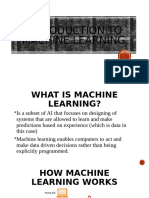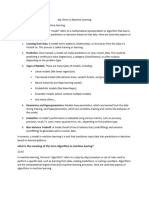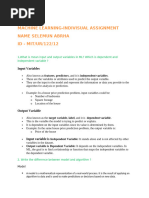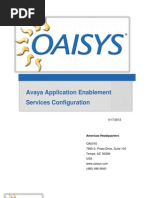GlobalLogic - Optimization Algorithms For Machine Learning
Uploaded by
Kumar manickamGlobalLogic - Optimization Algorithms For Machine Learning
Uploaded by
Kumar manickamThis article explores the optimization algorithms for machine learning models.
In this use case scenario, we explore how an optimized machine learning model
can be used to predict employee attrition.
Introduction
Employers generally consider attrition a loss of valuable employees and talent;
however, there is more to attrition than a shrinking workforce. When employees
leave an organization, they take with them much-needed skills and qualifications they developed
during their tenure. There is no way for employers to know which employees will leave the
company, but a well-trained machine learning model can be used to predict attrition. We will
look at some of the optimization algorithms to improve the performance of the model.
Optimization is the most crucial part of machine learning algorithms. It begins with defining loss
function/cost function and ends with minimizing loss and cost using optimization algorithms
These help us maximize or minimize an error function. The internal parameters of a model play a
very important role in efficiently and effectively training a model and producing accurate results.
This is why we use various optimization algorithms to update and calculate appropriate and
optimum values of a model’s parameters. This, in turn, improves our model’s learning process, as
well as its output.
The article covers the following topics:
1) Dataset
(detailed explanation in the link below)
2) Data Cleaning
(detailed explanation in the link below)
3) Converting Categorical Features to Numerical
(detailed explanation in the link below)
4) Split Between Training and Test Dataset
(detailed explanation in the link below)
5) Training the Model
(detailed explanation in the link below)
6) Checking the Model Accuracy
(detailed explanation in the link below)
7) Considering Alternative Models for Classification
(detailed explanation in the link below)
8) Feature Selection Using Model Importance
(detailed explanation in the link below)
9) Optimizing Model Performance Using Optimization Algorithms
(detailed explanation in the link below)
Head out to *link* read about all the above topics in brief.
It also includes a lot of important code snippets as well.
Coming to the methods themselves, we have;
1)Batch Normalization
Batch normalization is a method used to normalize the inputs of each layer
in order to fight the internal covariate shift problem, thereby improving
the performance and stability of neural networks. This also makes more
sophisticated deep-learning architectures.
The basic idea behind batch normalization is to limit covariate shift by
normalizing the activations of each layer (transforming the inputs to be mean 0
and unit variance). This allows each layer to learn on a more stable distribution
of inputs and would thus accelerate the training of the network.
We normalize the input layer by adjusting and scaling the activations, which
allows each layer of a network to learn more independently of other layers.
2) Grid-Search
Grid-searching is the process of searching the data to configure optimal
parameters for a given model. There are certain parameters necessary
depending on the type of model utilized. Grid-searching does not apply to only
one model type. Grid-searching can be applied to calculate the best parameters
to use for any given model across machine learning. It works in an iterative way.
For some of the parameters associated with the model, we enter good probable
values and the grid-search iterates through each of them, compares the result
for each value, and then gives you the parameters best suited for your model.
3) Stochastic Gradient Descent
Stochastic gradient descent (SGD) is an optimization algorithm in which
samples are selected randomly instead of using a whole data set for each
iteration or using data in the order they appear in the training set. We adjust the
weights after each iteration for our neural network.
In a typical gradient descent, the whole dataset is taken as a batch (the
total number of samples from a dataset used to calculate the gradient for
each iteration) which is problematic when the dataset is significantly large.. It
becomes computationally expensive to perform. Stochastic gradient descent
solves this problem by using a single sample to perform each iteration.
Clink on the link to read about the methods in detail. There are advantages and disadvantages
provided for each along with code snippets.
Conclusion
We implemented different models to predict attrition in a company, measured
their accuracy, and employed the various optimization algorithms on a support
vector machine to optimize its parameters. We observed that the accuracy
of a model is improved by 3.4% - 94% without optimization and 97.4% with
optimization using grid search. In this case, it is not a significant improvement.
However, in reality we might have many more data sets where optimization
improves performance significantly.
The purpose of the paper is to give an idea of various optimization techniques
and how optimization helps to improve performance of any machine learning
model.
Finally, we have a working model to predict which employees will leave the
company and who will stay based on five input parameters with an accuracy of
almost 98 percent.
You might also like
- Hourglass Workout Program by Luisagiuliet 276% (21)Hourglass Workout Program by Luisagiuliet 251 pages
- The Hold Me Tight Workbook - Dr. Sue Johnson100% (16)The Hold Me Tight Workbook - Dr. Sue Johnson187 pages
- Read People Like A Book by Patrick King-Edited62% (66)Read People Like A Book by Patrick King-Edited12 pages
- Livingood, Blake - Livingood Daily Your 21-Day Guide To Experience Real Health77% (13)Livingood, Blake - Livingood Daily Your 21-Day Guide To Experience Real Health260 pages
- COSMIC CONSCIOUSNESS OF HUMANITY - PROBLEMS OF NEW COSMOGONY (V.P.Kaznacheev,. Л. V. Trofimov.)94% (212)COSMIC CONSCIOUSNESS OF HUMANITY - PROBLEMS OF NEW COSMOGONY (V.P.Kaznacheev,. Л. V. Trofimov.)212 pages
- Donald Trump & Jeffrey Epstein Rape Lawsuit and Affidavits83% (1016)Donald Trump & Jeffrey Epstein Rape Lawsuit and Affidavits13 pages
- The 36 Questions That Lead To Love - The New York Times94% (34)The 36 Questions That Lead To Love - The New York Times3 pages
- The 36 Questions That Lead To Love - The New York Times95% (21)The 36 Questions That Lead To Love - The New York Times3 pages
- Jeffrey Epstein39s Little Black Book Unredacted PDF75% (12)Jeffrey Epstein39s Little Black Book Unredacted PDF95 pages
- The 4 Hour Workweek, Expanded and Updated by Timothy Ferriss - Excerpt23% (954)The 4 Hour Workweek, Expanded and Updated by Timothy Ferriss - Excerpt38 pages
- Summary of The Article: A Few Useful Things To Know About Machine LearningNo ratings yetSummary of The Article: A Few Useful Things To Know About Machine Learning3 pages
- OpenText StreamServe 5.6 StreamOUT User GuideNo ratings yetOpenText StreamServe 5.6 StreamOUT User Guide32 pages
- Q. (A) What Are Different Types of Machine Learning? Discuss The DifferencesNo ratings yetQ. (A) What Are Different Types of Machine Learning? Discuss The Differences12 pages
- Chapter 4 - A Primer On Machine Learning For Marketing AnalyticsNo ratings yetChapter 4 - A Primer On Machine Learning For Marketing Analytics23 pages
- Chapter-3-Common Issues in Machine LearningNo ratings yetChapter-3-Common Issues in Machine Learning20 pages
- Air quality prediction using machine learningNo ratings yetAir quality prediction using machine learning29 pages
- Software Defect Prediction Using Ensemble LearningNo ratings yetSoftware Defect Prediction Using Ensemble Learning6 pages
- Introduction_to_Machine_Learning_ExercisesNo ratings yetIntroduction_to_Machine_Learning_Exercises18 pages
- Approach Towards Model Evaluation, Model SelectionNo ratings yetApproach Towards Model Evaluation, Model Selection13 pages
- 20 Questions On Feature Engineering and EdaNo ratings yet20 Questions On Feature Engineering and Eda9 pages
- Data Science Important Interview Questions & Answers✅No ratings yetData Science Important Interview Questions & Answers✅19 pages
- Electricity Load Forecasting - IntelligentNo ratings yetElectricity Load Forecasting - Intelligent10 pages
- Lecture 5 - Feature extraction, model building & evaluationNo ratings yetLecture 5 - Feature extraction, model building & evaluation35 pages
- Predicting Stock Values Using A Recurrent Neural NetworkNo ratings yetPredicting Stock Values Using A Recurrent Neural Network12 pages
- In Depth Explanation of Machine Learning ConceptsNo ratings yetIn Depth Explanation of Machine Learning Concepts3 pages
- Which Machine Learning Algorithm Should I Use - The SAS Data Science BlogNo ratings yetWhich Machine Learning Algorithm Should I Use - The SAS Data Science Blog15 pages
- DATA MINING AND MACHINE LEARNING. PREDICTIVE TECHNIQUES: REGRESSION, GENERALIZED LINEAR MODELS, SUPPORT VECTOR MACHINE AND NEURAL NETWORKSFrom EverandDATA MINING AND MACHINE LEARNING. PREDICTIVE TECHNIQUES: REGRESSION, GENERALIZED LINEAR MODELS, SUPPORT VECTOR MACHINE AND NEURAL NETWORKSNo ratings yet
- DATA MINING and MACHINE LEARNING. PREDICTIVE TECHNIQUES: ENSEMBLE METHODS, BOOSTING, BAGGING, RANDOM FOREST, DECISION TREES and REGRESSION TREES.: Examples with MATLABFrom EverandDATA MINING and MACHINE LEARNING. PREDICTIVE TECHNIQUES: ENSEMBLE METHODS, BOOSTING, BAGGING, RANDOM FOREST, DECISION TREES and REGRESSION TREES.: Examples with MATLABNo ratings yet
- Pocket Certificates Using Double Encryption: FeaturesNo ratings yetPocket Certificates Using Double Encryption: Features4 pages
- Kendriya Vidyalaya Sangathan Sample PaperNo ratings yetKendriya Vidyalaya Sangathan Sample Paper15 pages
- Value Help in Adobe Interactive Forms: Installation (ZCI)No ratings yetValue Help in Adobe Interactive Forms: Installation (ZCI)6 pages
- Avaya Application Enablement Services ConfigurationNo ratings yetAvaya Application Enablement Services Configuration13 pages
- AutoCAD Civil 3D Help - Layer Properties ManagerNo ratings yetAutoCAD Civil 3D Help - Layer Properties Manager3 pages
- Rfid Based Security System Using Arduino ModuleNo ratings yetRfid Based Security System Using Arduino Module3 pages
- Computer Architecture: Lecture: 9 - 13 Types of Memories Cache, Internal and ExternalNo ratings yetComputer Architecture: Lecture: 9 - 13 Types of Memories Cache, Internal and External69 pages
- Livingood, Blake - Livingood Daily Your 21-Day Guide To Experience Real HealthLivingood, Blake - Livingood Daily Your 21-Day Guide To Experience Real Health
- COSMIC CONSCIOUSNESS OF HUMANITY - PROBLEMS OF NEW COSMOGONY (V.P.Kaznacheev,. Л. V. Trofimov.)COSMIC CONSCIOUSNESS OF HUMANITY - PROBLEMS OF NEW COSMOGONY (V.P.Kaznacheev,. Л. V. Trofimov.)
- Donald Trump & Jeffrey Epstein Rape Lawsuit and AffidavitsDonald Trump & Jeffrey Epstein Rape Lawsuit and Affidavits
- The 36 Questions That Lead To Love - The New York TimesThe 36 Questions That Lead To Love - The New York Times
- The 36 Questions That Lead To Love - The New York TimesThe 36 Questions That Lead To Love - The New York Times
- Jeffrey Epstein39s Little Black Book Unredacted PDFJeffrey Epstein39s Little Black Book Unredacted PDF
- The 4 Hour Workweek, Expanded and Updated by Timothy Ferriss - ExcerptThe 4 Hour Workweek, Expanded and Updated by Timothy Ferriss - Excerpt
- Summary of The Article: A Few Useful Things To Know About Machine LearningSummary of The Article: A Few Useful Things To Know About Machine Learning
- Q. (A) What Are Different Types of Machine Learning? Discuss The DifferencesQ. (A) What Are Different Types of Machine Learning? Discuss The Differences
- Chapter 4 - A Primer On Machine Learning For Marketing AnalyticsChapter 4 - A Primer On Machine Learning For Marketing Analytics
- Software Defect Prediction Using Ensemble LearningSoftware Defect Prediction Using Ensemble Learning
- Approach Towards Model Evaluation, Model SelectionApproach Towards Model Evaluation, Model Selection
- Data Science Important Interview Questions & Answers✅Data Science Important Interview Questions & Answers✅
- Lecture 5 - Feature extraction, model building & evaluationLecture 5 - Feature extraction, model building & evaluation
- Predicting Stock Values Using A Recurrent Neural NetworkPredicting Stock Values Using A Recurrent Neural Network
- Which Machine Learning Algorithm Should I Use - The SAS Data Science BlogWhich Machine Learning Algorithm Should I Use - The SAS Data Science Blog
- DATA MINING AND MACHINE LEARNING. PREDICTIVE TECHNIQUES: REGRESSION, GENERALIZED LINEAR MODELS, SUPPORT VECTOR MACHINE AND NEURAL NETWORKSFrom EverandDATA MINING AND MACHINE LEARNING. PREDICTIVE TECHNIQUES: REGRESSION, GENERALIZED LINEAR MODELS, SUPPORT VECTOR MACHINE AND NEURAL NETWORKS
- DATA MINING and MACHINE LEARNING. PREDICTIVE TECHNIQUES: ENSEMBLE METHODS, BOOSTING, BAGGING, RANDOM FOREST, DECISION TREES and REGRESSION TREES.: Examples with MATLABFrom EverandDATA MINING and MACHINE LEARNING. PREDICTIVE TECHNIQUES: ENSEMBLE METHODS, BOOSTING, BAGGING, RANDOM FOREST, DECISION TREES and REGRESSION TREES.: Examples with MATLAB
- Pocket Certificates Using Double Encryption: FeaturesPocket Certificates Using Double Encryption: Features
- Value Help in Adobe Interactive Forms: Installation (ZCI)Value Help in Adobe Interactive Forms: Installation (ZCI)
- Avaya Application Enablement Services ConfigurationAvaya Application Enablement Services Configuration
- Computer Architecture: Lecture: 9 - 13 Types of Memories Cache, Internal and ExternalComputer Architecture: Lecture: 9 - 13 Types of Memories Cache, Internal and External



































